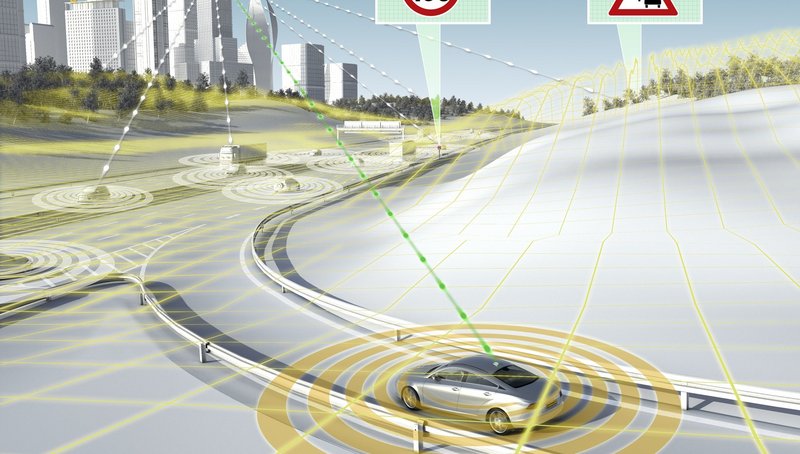Predictive Assistance: Continental Presents Adaptive Cruise Control with eHorizon
- In a test vehicle, Continental displays the combination of adaptive cruise control and elements of the dynamic eHorizon
- eHorizon from Continental complements vehicle sensors with highly accurate map data and additional route and surroundings information
- The test vehicle takes over full longitudinal control or informs the driver via accelerator force feedback pedal
Frankfurt, Regensburg, Germany, 15 July 2015. Current advanced driver assistance systems make their decisions on the basis of information from vehicle surroundings sensors, such as cameras and radar systems, as well as additional on-board sensors. They can improve further and develop into highly and fully automated systems with additional information on their surroundings and the road in front of them, such as lane specific road maps, topographical information, and traffic commands and restrictions. With its electronic horizon (eHorizon) the international Automotive supplier is offering a solution to further and enable this development. To prove the effectiveness of this concept, Continental is presenting a test vehicle in which an Adaptive Cruise Control is combined with elements of the dynamic eHorizon for the first time. The Connected Enhanced Cruise Control test vehicle demonstrates this combination on the road. The eHorizon combines the precise accuracy of road maps from HERE, a subsidiary from Nokia, and the sensor information from the vehicle with additional levels of information. This includes data on lane-keeping and routing, as well as additional route information such as the curve radius and upward and downward slopes, plus driving-related data such as current traffic commands and restrictions (for example, speed limits, overtaking bans, etc.).
"With the connected cruise control, we are demonstrating how advanced driver assistance systems benefit when the vehicle looks around the corner. The result is even more convenient support for the driver," explains Dr. Frank Försterling, Head of Sales and Portfolio for Innovations at Interior Electronics Solutions, Continental.
eHorizon and accelerator force feedback pedal provide information on speed limits
The test vehicle regulates driving speed in ACC mode and takes over full longitudinal control, not only depending on vehicles in front but also taking into account additional environmental parameters such as the road characteristics or speed limits contributed by the eHorizon. The speed control also considers the curve radii of the current road. "With the Connected Enhanced Cruise Control, all the driver has to do is steer. With this system, we are implementing another important element in the movement toward highly and fully automated driving," comments Dr. Stefan Lüke, Head of Advanced Driver Assistance Systems & Automation in the Advanced Engineering department of Continental's Chassis & Safety division. For testing on a closed site, Continental's cooperation partner HERE specifically measured the Continental test track at the Contidrom near Hanover for its high-definition map.
The accelerator force feedback pedal developed by Continental is also installed in the test vehicle. It uses specific amounts of resistance to remind the driver to adhere to current speed limits or to warn the driver if a curve is being approached too quickly. The system has several objectives. It is intended to increase driving safety and relieve the burden on the driver while simultaneously increasing efficiency by reducing the vehicle's fuel consumption and thus its CO2 emissions.
Big data analyses on the basis of cloud computing
Further development of the system into a complete "dynamic eHorizon" is also planned for the future. As part of this, additional information is constantly updated via an online connection. A mobile radio module installed in the vehicle enables data to be exchanged in both directions. The vehicle thereby receives constantly updated route and surroundings information such as additional topographical data or information on the current traffic situation. "The information delivered online is always integrated with the data and sensor information available in the vehicle so that security-relevant systems have several redundant data sources at all times. This way, we prevent actions being taken on the basis of incorrect data," explains Lüke.
At the same time, however, the vehicle itself takes charge of recording and providing data for the entire system – for example, by measuring the curve radius of the current road or recording additional information, such as permissible speeds, positioning that is accurate down to the individual lane, and providing this to the backend. In doing so, the vehicle makes its own contribution to constant improvement and updating of the map material and the additional information.
Aggregation and analysis of the data provided from various sources is performed by a highly scalable backend platform created in cooperation with IBM. As a result, the dynamic eHorizon can not only be built up for the entire German highway network but can also be offered worldwide.

Sebastian Fillenberg
Head of External Communications
Continental Automotive

Sören Pinkow
Media Spokesperson Autonomous Mobility and Commercial Vehicles
Continental Automotive

